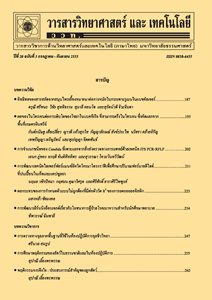Effect of 3D-printed Mold Insert on the Dimensional Stability of Injection Molded Parts
Main Article Content
Abstract
3D printing has been well established for prototyping plastic parts. However, the 3D printed parts show mechanical properties lower than the real injection molded parts of the desired material. Therefore, there has been some interest in using 3D printing to produce plastic mold inserts. Conventionally, the mold inserts (MI) are made from steel, which are expensive and take long building time. Thus, the quality, cost, and lead time of the mold affect the economics of production, especially in the automotive industry. In this work, PolyJet 3D printing technology was applied to build MI using photopolymer resin (Digital ABS). Polypropylene (PP) was materials of interest to be injected into 3D-printed mold inserts (3DMIs) using different injection parameters. The parameters investigated here were injection speed, packing pressure, melt temperature, and mold cooling time. The experiments were designed by using the Taguchi method. It showed that the injection parameters affected the dimension of injected parts produced by using 3DMIs. It was found that the width and length of injected parts depended mainly on melt temperature. The thickness of injected parts depended mainly on mold cooling time. When producing real products by using the best combinations from Taguchi method, the products shrunk, especially the thickness because 3DMIs possessed bad heat transfer and had no cooling channel. The products had a higher degree of crystallinity than the products produced from the conventional mold with the cooling channel.
Article Details
References
Rosato, D.V. and Rosato, M.G., 2012, Injection Molding Handbook, Springer Science & Business Media, New York.
Amaya, H.E., Hills V. and Crounse, D.K., 2002, Method for the Rapid Fabrication Mold Inserts, US 2002/0187065.
Mendible, G.A., Rulander, J.A. and Johnston, S.P., 2017, Comparative study of rapid and conventional tooling for plastics injection molding, Rapid Prototyping J. 23: 344-352.
Kashyap, S. and Datta, D., 2015, Process parameter optimization of plastic injection molding: a review, Int. J. Plast. Technol. 19: 1-18.
Altan, M., 2010, Reducing shrinkage in injection moldings via the Taguchi, ANOVA and neural network methods, Mater. Des. 31: 599-604.
Erzurumlu, T. and Ozcelik, B., 2006, Minimization of warpage and sink index in injection-molded thermoplastic parts using Taguchi optimization method, Mater. Des. 27: 853-861.
Ozcelik, B., 2011, Optimization of injection
parameters for mechanical properties of specimens with weld line of polypropylene using Taguchi method, Int. Comm. Heat Mass Transfer. 38: 1067-1072.
Bak, D., 2003, Rapid prototyping or rapid production? 3D printing processes move industry towards the latter, Assembly Automat. 23: 340-345.
Garden, J., 2016, Additive manufacturing technologies: State of the art and trends, Int. J. Prod. Res. 54: 3118-3132.
Coon, C., Pretzel, B., Lomax, T. and Strlič, M., 2016, Preserving rapid prototypes: A review, Herit. Sci. 4.1: 40.
Nelson, J.W., LaValle, J.J., Kautzman, B.D., Dworshak, J.K., Johnson, E.M. and Ulven, C.A., 2017, Injection Molding with an additive manufacturing tool, Plast. Eng. 73: 60-66.
Knukua, A., 2007, Injection Molding Quality Improvement by Taguchi Method, Thammasat University, Pathum Thani.
Du, M., Guo, B., Wan, J., Zou, Q. and Jia, D., 2010, Effects of halloysite nanotubes on kinetics and activation energy of non-isothermal crystallization of poly propylene, J. Polym. Res. 17:109-118.


